Capella Space X-Band Synthetic Aperture Radar
EO
Land
Multi-purpose imagery (land)
Land surface imagery
Capella Space is a space technology company with data and satellite solutions for government and commercial use. Capella’s SAR satellites provide access to information to a number of industries worldwide, including defense and intelligence, supply chain, insurance, maritime and others.
Quick facts
Overview
| Mission type | EO |
| Agency | Capella Space |
| Mission status | Operational (nominal) |
| Launch date | 03 Dec 2018 |
| Measurement domain | Land |
| Measurement category | Multi-purpose imagery (land) |
| Measurement detailed | Land surface imagery |
| Instruments | Capella X-SAR |
| Instrument type | Imaging microwave radars |
| CEOS EO Handbook | See Capella Space X-Band Synthetic Aperture Radar summary |

Summary
About Capella Space
Capella Space is a space technology company with data and satellite solutions for government and commercial use, delivering commercial SAR imagery. Capella provides access to information affecting industries worldwide, including defense and intelligence, supply chain, insurance, maritime and others. Its SAR satellites deliver global insights into commerce, conservation, and security on Earth. Capella is headquartered in San Francisco, California with additional locations in Denver, Colorado and Washington, D.C.
Objectives and Applications
Capella Space is a space tech company with data and satellite solutions for government and commercial use. Capella delivers the best quality, highest resolution SAR imagery commercially available. Capella provides easy access to frequent and timely information affecting dozens of industries worldwide, including defense and intelligence, supply chain, insurance, maritime and others. Its market-leading SAR satellites are matched with unparalleled data infrastructure to quickly deliver reliable global insights that sharpen our understanding of the changing world.
Mission Capabilities
Each Capella Space satellite features an X-band Synthetic Aperture Radar (SAR) instrument, which operates with a bandwidth from 500 MHz up to 700MHz. This single-polarized instrument allows for imaging in various modes including spotlight, stripmap, and sliding spotlight. In certain modes the user can select the image size and is able to trade resolution for image quality, which enables a variety of uses including monitoring military threats, observing glacial meltwater dynamics, coordinating disaster response, detecting vessels at sea and persistent global change monitoring.
Performance Specifications
Spotlight mode provides high resolution imaging at 0.25 meter azimuth resolution for a swath of 5 x 5 km. The sliding-spotlight mode produces an image at 0.5 meter azimuth resolution at a scene length up to 10 km. Stripmap mode produces imagery at 1.2 meter azimuth resolution up to 100 km x 10 km.
Capella’s satellites operate in a variety of orbits at 45-degree mid-inclination (525 km altitude), 53-degree mid-inclination (575 km altitude), and 97-degree sun-synchronous orbit (525 km altitude). They have a period of 90 minutes which provides a revisit time of 2-5 hours with eight satellites.
Space and Hardware Components
The Capella's second-generation Whitney-class satellites have a mass of 110 kg and third-generation Acadia-class satellites have a mass less than 197 kg. With each launch of new satellites, Capella makes improvements to the instruments and radar system performance, such as the inclusion of polarimetric measurements in the next development. Once deployed, the small satellites unfold an antenna spanning approximately 8 square meters.
Capella Platform
Capella’s automated platform provides customers with direct access to task Capella satellites and collect imagery, making the Capella user experience as simple and straightforward as possible. Users can login to Console, define their area of interest, and search the existing catalog or submit a new acquisition tasking request. Once a new acquisition is collected, automatically processed, and delivered, customers receive an alert so they can login and access the SAR imagery in a timely manner.
Capella X-SAR (Synthetic Aperture Radar) Constellation
Sensor Complement Capella Spacecraft Capella Launches Mission Status References
Capella Space is a U.S. satellite manufacturer and Earth observation company and the first American company to bring commercial SAR data to the broader market. Founded in 2016, Capella Space’s Synthetic Aperture Radar (SAR) satellites enable the company to deliver the highest quality, high resolution SAR • imagery commercially available with the fastest order-to-delivery time, empowering organizations across the public and private sector to make informed, accurate decisions.
The Capella constellation will grow to 9 small satellites by the end of 2023. The first satellite of the Capella constellation launched in 2018. As of 2024 10 more satellites have been launched, with at least five more planned. 40) The radars are single polarization X-band systems, capable of operating at 500 - 700 MHz bandwidth in stripmap, spotlight, and sliding spotlight imaging modes.

Figure 1: Charts illustrating global revisit rates and collects per day from the full constellation (image credit: Capella Space)
Each Capella satellite has a three-year design life. By launching 12 satellites per year, the constellation will maintain its imaging capability indefinitely. With the ability to continually update and refresh the satellite technology, Capella will be able implement improvements to the constellation and radar performance quarterly.
Parameter | 2018 | 2020 | 2021 | 2022 | 2023 |
Number of satellites launched | 1 | 1 | 4 | 2 | 5+ |
Use | Internal demonstration | Operational | Operational | Operational | Operational |
Total number of satellites | 1 | 1 | 5 | 7 | 5+ |
Number of orbital planes | xx | 1 | 3 | 3 | 3 |
Maximum revisit | weekly | 3-6 hours | 2-4 hours | 1-3 hours | 1-2 hours |
Sensor Complement (SAR)
Capella SAR satellites operate at X-band with a bandwidth of up to 700 MHz. Ground resolution and swath width vary with look angle (Figure 2), but users will be able to select a combination of transmit bandwidth and PRF to meet their imaging requirements. The first Capella radars will operate with a single polarization. Improvement in radar system performance, such as polarimetric measurements, are planned for future generations of Capella satellites.
The system specifications for Capella’s satellites are listed in Table 2.
Frequency band | X-band (9.4 – 9.9 GHz) |
Polarization | Single-polarization (HH or VV) |
Orbit, orbital period, inclination | Polar & MIO, ~90 minutes, 97º, 53º & 45º |
Altitude at the equator | 485 – 525 km |
Imaging modes | Stripmap, spotlight, sliding spotlight |
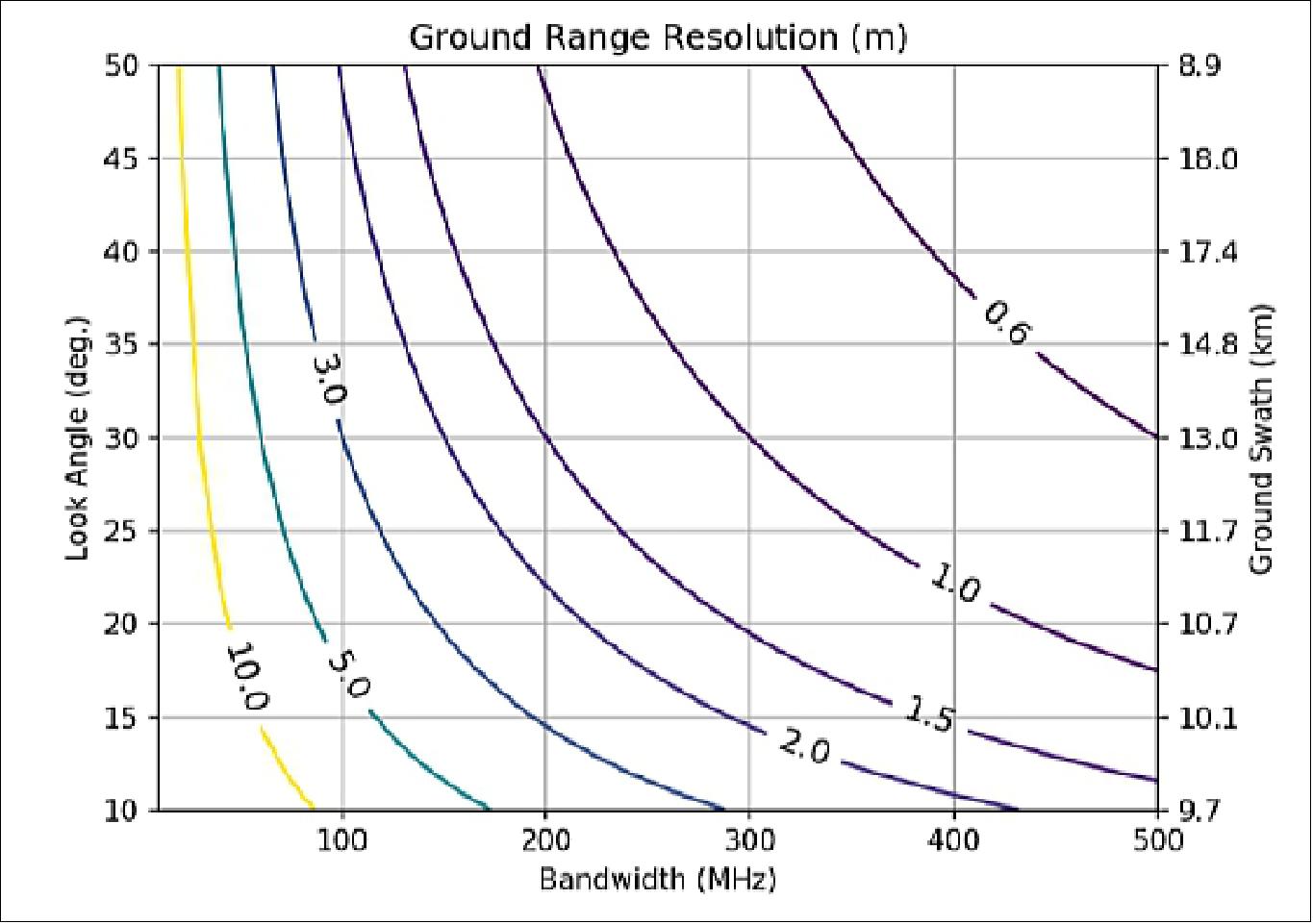
Radar Imaging Modes
The Capella satellites will be capable of imaging in several modes, including spotlight, sliding spotlight, and traditional stripmap. These modes are described below. Note that for most modes, the user can select the image size, and is able to trade resolution for imaging quality.
Spotlight: Capella satellites are capable of spotlight imaging, in which the beam is focused on a single point on the Earth throughout the acquisition. In this mode, azimuth resolution is limited by the duration of antenna beam on the target. US regulations control the resolution at which Capella can sell imagery. These multi-looked images are acquired using a dwell time that results in a finer azimuth resolution than 0.25 m. The raw SAR data is processed to full resolution, and then pixels in the amplitude-only image are averaged (multi-looked) to produce high-resolution, speckle-free imagery that Capella is legally permitted to sell.
Multi-looking reduces speckle and increases detectability of objects in a SAR image. However, with many SAR systems, multi-looking comes at the cost of coarser azimuth resolution. Because Capella spacecraft can stare at a point on the ground for tens of seconds, Capella can provide multi-looked images constructed from tens of looks at very high final resolution, e.g., 0.3 m.
An example of the improvement in image quality achieved through multi-looked staring-spotlight has been simulated using airborne circular data. Simulated Capella multi-looked staring spotlight images are shown in Figure 3 (rows 2 through 5). Simulated single-look staring-spotlight acquisition images are shown in Figure 3 (row 1). The scene contains a road, cars in a parking lot, and several corner reflectors. NESZ values of typical large SAR systems such as TerraSAR-X are chosen to simulate the non-Capella radar simulated images. The simulations highlight contrast recovered in a SAR image by multi-looked staring-spotlight data processing, even when the NESZ is relatively poor (right-most column, rows 3, 4, and 5 in Figure 3. For example, the road emerges clearly in the 10-, 20-, and 30-look Capella images, but is hard to distinguish in the non-Capella radar single-look image despite that system having a lower NESZ. Note that in each column, multi-looking does not degrade resolution.
Capella satellites will also be able to acquire multiple staring spotlight images adjacent to each other. Each acquisition will have a shorter dwell time than the maximum dwell time possible with a single-spot staring spotlight acquisition, so either the resolution of each spot will be degraded as the number of spots increases, or the number of looks available for multi-looking will decrease as the number of spots increases. This mode is useful for extending the width (swath) of an area being imaged. For imaging a larger area in the along-track direction, i.e., increasing the length of a spotlight acquisition, sliding spotlight (see below) is more efficient. Maximum image sizes for 0.3 m and 1 m azimuth resolutions and associated number of looks for staring spotlight and multi-spot spotlight are shown in Table 3.
Maximum Image Size (km x km) | Azimuth Resolution (m) | Number of Looks |
5 x 20, 10 x 10 | 0.3 | 10 |
5 x 20, 10 x 10 | 0.3 | 20 |
5 x 10 | 0.3 | 30 |
5 x 30, 15 x 10 | 1.0 | 10 |
5 x 20, 10 x 10 | 1.0 | 20 |
5 x 20, 10 x 10 | 1.0 | 30 |
Sliding Spotlight: This mode is a standard Synthetic Aperture Radar imaging mode. The swath is limited by a combination of the look angle, the radar beamwidth, and the Pulse Repetition Frequency (PRF) selected for the acquisition. The PRF is selected to either provide maximum swath with reduced azimuth ambiguity sidelobe ratio performance, or reduced swath with better azimuth ambiguity sidelobe ratio performance. The minimum slant range resolution is 0.3 m.
Capella satellites capture a wide-swath SAR image in a single horizon-to-horizon pass by collecting multiple sequential stripmap swaths adjacent in the range direction. The number of sequential stripmap swaths is limited by the length of the final wide-swath image and spacecraft slewing times. Stripmap image sizes are listed in Table 5.
Image Length (km) | Best Theoretical Azimuth Resolution (m) |
10 | 0.018 |
20 | 0.034 |
30 | 0.049 |
40 | 0.065 |
50 | 0.080 |
60 | 0.095 |
70 | 0.109 |
80 | 0.124 |
90 | 0.137 |
100 | 0.151 |
125 | 0.184 |
150 | 0.215 |
175 | 0.243 |
200 | 0.274 |
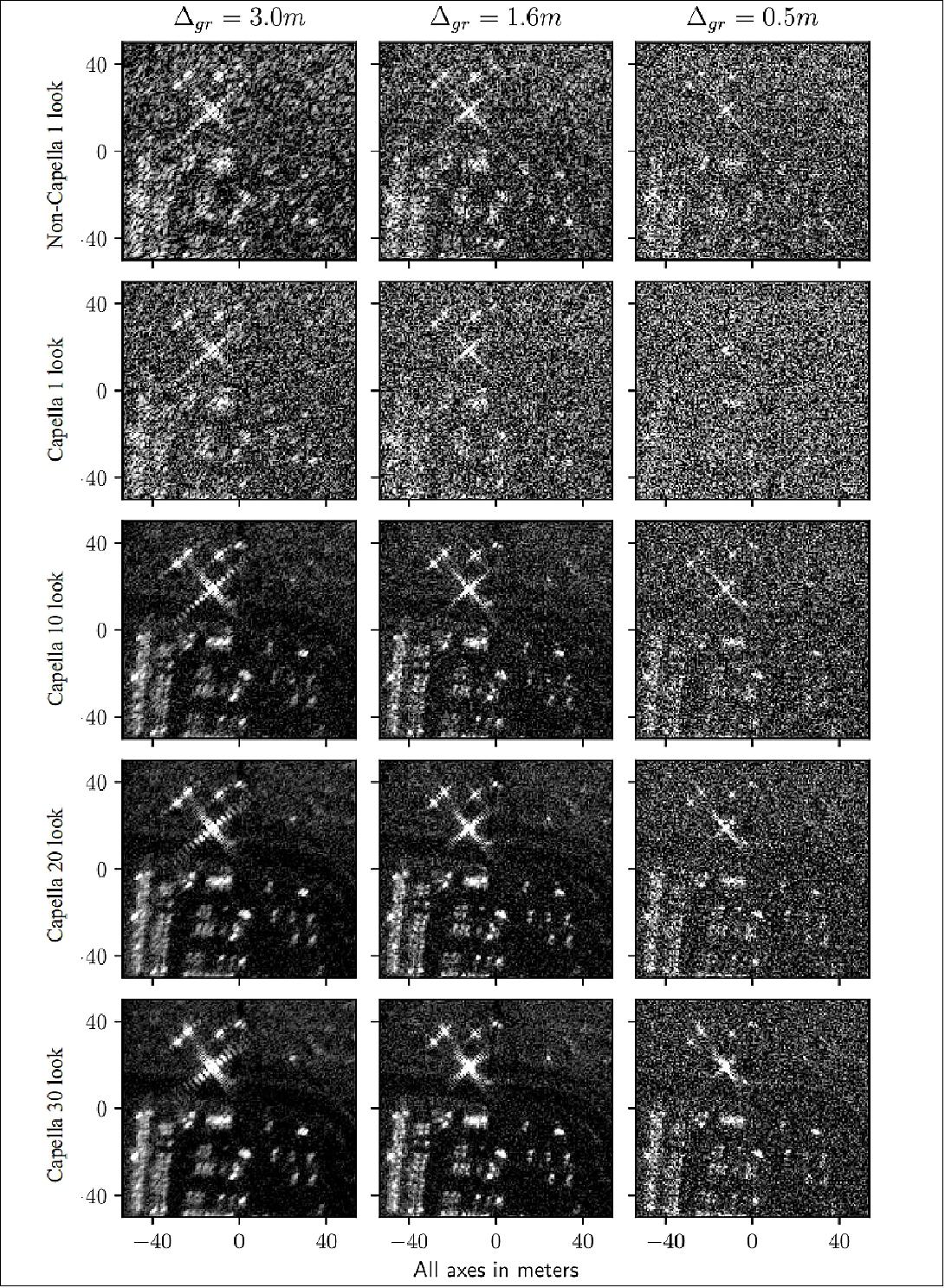
Stripmap and Multi-swath Stripmap: This mode is a standard synthetic aperture radar stripmap imaging mode. The swath is limited by a combination of the look angle, the radar beamwidth, and the PRF (Pulse Repetition Frequency) selected for the acquisition. The PRF is selected to either provide maximum swath with reduced azimuth ambiguity sidelobe ratio performance, or reduced swath with better azimuth ambiguity sidelobe ratio performance. The minimum slant range resolution is 0.3 m.
Capella satellites will capture a single wide-swath SAR image in a single horizon-to-horizon pass by collecting multiple sequential stripmap swaths adjacent in the range direction. The number of sequential stripmap swaths is limited by the length of the final wide-swath image and spacecraft slewing times. Stripmap and multi-swath stripmap image sizes are listed in Table 5.
Image Length (km) | Image Width (km) |
10-30 | 50 |
40 | 40 |
50-140 | 30 |
150-780 | 20 |
790-2100 | 10 |
With six satellites in two planes, repeat-pass (repeat-track) interferometric measurements are possible according to timeseries 0 in Table 6 (i.e., collections at hours 0, 54, 120, 174, ...). In addition, a different timeseries of repeat-pass interferometric collections made at a different look angle, but of the same area on the ground, is possible 12 hours later, i.e., at timeseries 1 in Table 6 (hours 12, 66, 132, 186, ...). Notice that the timeseries sequence repeats after 10 time-series, or 120 hours (5 days), i.e., time-series 10 in Table 6 is timeseries 0 at 120 hours. A single timeseries is suitable for observing processes that change over time scales of five or more days.
Time Series Number | Hours from Start of the Sequence | |||
0 | 0 | 54 | 120 | 174 |
1 | 12 | 66 | 132 | 186 |
2 | 24 | 78 | 144 | 198 |
... | ... | ... | ... | ... |
9 | 108 | 162 | 228 | 282 |
10 | 120 | 174 | 240 | 294 |
Capella Spacecraft
Capella Space launched its first satellite on a SpaceX rocket in the fall of 2018, an important milestone in the company’s plan to build a constellation of the world’s smallest commercial radar satellites. When in orbit, the Capella satellites unfurl antennas made of a flexible material. Once deployed the satellite’s antennas span 8 m2 once unfurled.
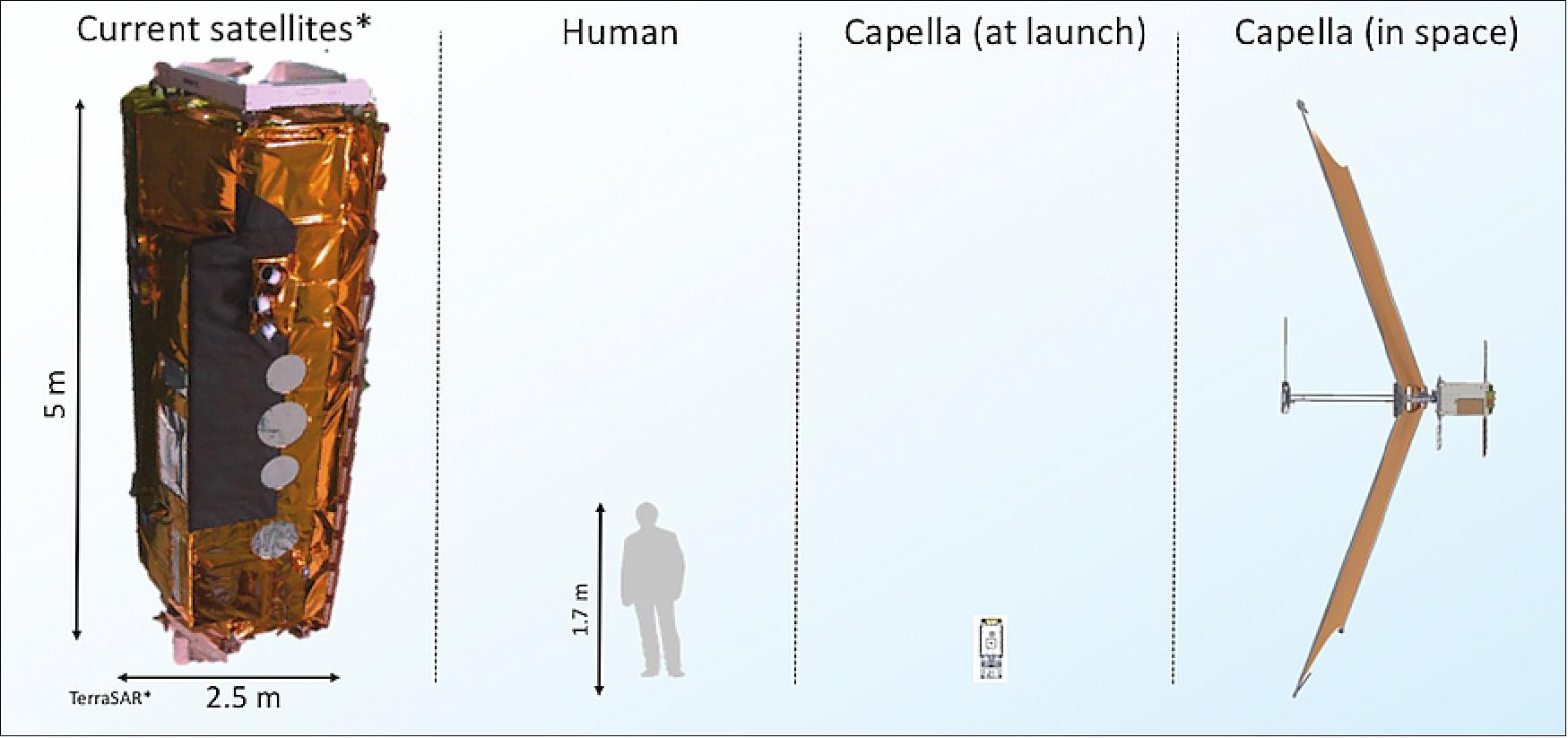
Capella Launches
| Spacecraft | Launch Date (UTC) | Launch Vehicle | Spaceport | Orbit | Description |
|---|---|---|---|---|---|
| Capella-15 (Acadia-5) | August 16, 2024, 18:56 UTC | Falcon-9, Transporter-11 Rideshare mission | Space Launch Complex 4E (SLC-4E), Vandenberg Space Force Base (VSFB) | Sun-synchronous orbit Altitude: 510-600 km
| Launched onboard SpaceX’s rocket |
| Capella-13 (Acadia-3) | August 11, 2024, 13:18 UTC | Rocket Lab Electron | Launch Complex 1 on New Zealand’s Mahia Peninsula | 53º inclination and an altitude of 615 km | Launched onboard Rocket Lab’s vehicle |
| Capella-14 (Acadia-4) | April 7, 2024, 23:16 UTC | Bandwagon-1 rideshare mission | Launch Complex 39A (LC-39A) at Kennedy Space Center (KSC) | 45.4º inclination and an altitude of 590 km | Launched onboard SpaceX’s rocket |
| Capella-12 (Acadia-2) | September 19, 2023, 06:55 UTC | Rocket Lab Electron, Mission’s name: "We Will Never Desert You" | Launch Complex 1 on New Zealand’s Mahia Peninsula | Circular orbit with 635 km altitude. | Launched onboard Rocket Lab’s vehicle. |
| Capella-11 (Acadia-1) | August 23, 2023, 23:45 UTC | Rocket Lab Electron | Launch Complex 1 on New Zealand’s Mahia Peninsula | 53º inclination and an altitude of 646.8 km | Launched onboard Rocket Lab’s vehicle |
| Capella-9 (Capella Whitney 7), Capella-10 (Capella Whitney 8) | March 16, 2022, 22:38 UT | Rocket Lab Electron | US launchpad at Wallops Island, Virginia | 44º inclination and an altitude of 600 km | Launched onboard Rocket Lab’s vehicle |
| Capella-7 (Capella Whitney 5), Capella-8 (Capella Whitney 6) | January 13, 2022, 15:25 UTC | Falcon-9, Transporter-3 Rideshare | Space Launch Complex 40 at the Cape Canaveral Space Force Station | Sun-synchronous orbit with 536 km altitude | Launched onboard SpaceX’s rocket |
| Capella-5 (Capella Whitney 3) | June 30, 2021, 19:31 UTC | Falcon-9, Transporter-2 Rideshare | Space Launch Complex 40 at the Cape Canaveral Space Force Station | Sun-Synchronous orbit with altitude of nearly 550 km and 97.5º inclination | Launched onboard SpaceX’s rocket |
| Capella-6 (Capella Whitney 4) | May 15, 2021, 22:56 UTC | Falcon-9, Starlink-26 mission | Launch Complex 39A (LC-39A) at Kennedy Space Center in Florida | Inclination of 53º and an altitude of 191.8º | Launched onboard SpaceX’s rocket |
| Capella-3 (Capella Whitney 1), Capella-4 (Capella Whitney 2) | January 24, 2021, 15:00 UTC | Falcon-9, Transporter-1 Rideshare | Cape Canaveral Air Force Station (SLC-40) | Sun-Synchronous orbit with altitude of 560 km and inclination of 97.6º | Launched onboard SpaceX’s rocket |
| Capella-2 (Sequoia) | August 30, 2020, 03:05 UTC | Rocket Lab Electron, 'I Can't Believe It's Not Optical' mission | Launch Complex 1 on New Zealand’s Mahia Peninsula | Near-circular orbit, altitude of 525 km, inclination of 45º | Launched onboard Rocket Lab’s vehicle |
| Capella-1 (Denali) | December 3, 2018, 18:34 UTC | Falcon-9, SSO-A Rideshare mission | VAFB (Vandenberg Air Force Base) in California | Sun-synchronous circular orbit with an altitude of 575 km, inclination of ~98º, LTDN (Local Time of Descending Node) of 10:30 hours | Launched onboard SpaceX’s rocket |
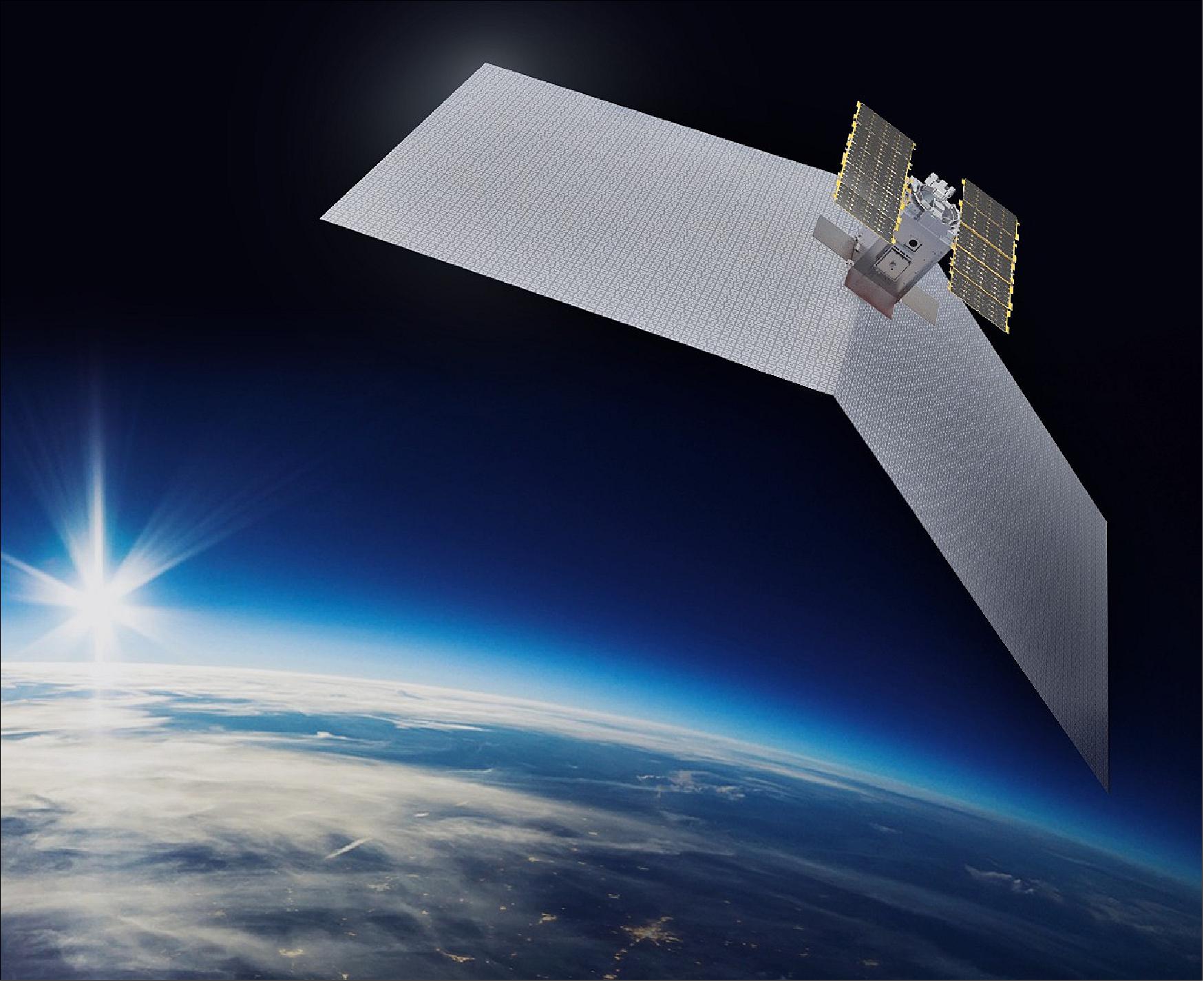
Mission Status
• August 16, 2024: Capella-15, also known as Arcadia-5, was successfully launched from Space Launch Complex 4E (SLC-4E) at Vandenberg Space Force Base (VSFB) at 18:56 UTC, onboard SpaceX’s Transporter-11 Rideshare mission on a Falcon-9 rocket. 47)
• August 11, 2024: Capella-13, also known as Arcadia-3, was successfully launched from New Zealand's Launch Complex 1 at Mahia at 13:18 UTC, onboard a Rocket Lab Electron vehicle. 45)
• April 7, 2024: Capella-14, also known as Arcadia-4, was successfully launched from Launch Complex 39A (LC-39A) at Kennedy Space Center (KSC) at 23:16 UTC, onboard SpaceX’s Bandwagon-1 rideshare mission. 46)
• September 19, 2023: The Capella-12 SAR satellite (Acadia-2), was launched on a dedicated Rocket Lab Electron vehicle at 06:55 UTC, from Rocket Lab Launch Complex 1 on New Zealand’s Mahia Peninsula.
The launch failed after approximately two minutes, because of space weather conditions. The liftoff and ascent of the first stage appeared to go as expected, with “nominal” calls by controllers up until stage separation. This mission, which the company called "We Will Never Desert You," was its ninth in 2023 and 41st overall.
Live video from the second stage, though, was lost right after separation, when the single Rutherford engine ignited. Telemetry displayed on the webcast for several seconds after stage separation showed the vehicle’s velocity decreasing, suggesting the upper engine had malfunctioned in some way, suffering an ignition failure or a premature shutdown, though that's just speculation. Rocket Lab did not identify a proximate or ultimate cause, saying in a post on X (formerly Twitter) that it will provide more information as it becomes available.
“Following lift-off from Launch Complex 1, the rocket successfully completed a first stage burn and stage separation as planned, before an issue was experienced at around T+ 2 minutes and 30 seconds into flight, resulting in the end of the mission,” Rocket Lab said in a statement after the failure.”
The failure is the third for the Electron in a little more than three years, with the previous two involving problems with the upper stage.
"We Will Never Desert You" aimed to deliver one of Capella Space's "Acadia" satellites to a circular orbit about 395 miles up (635 kilometers) above Earth. Tuesday's flight was the second in a four-launch contract to send these advanced SAR satellites skyward. 43)
• August 23, 2023: The Capella-11 SAR satellite (Acadia-1), was launched aboard the ‘We Love The Nightlife’ mission, on a dedicated Rocket Lab Electron vehicle at 23;45 UTC, from Rocket Lab Launch Complex 1 on New Zealand’s Mahia Peninsula. 42)
• March 16, 2023: Electron rocket, the second of its kind from Rocket Lab, placed into orbit two new Capella Space radar imaging satellites, Capella-9 (Whitney-7) and Capella-10 (Whitney-8). The launch occurred at Mid-Atlantic Regional Spaceport on Wallops Island, Virginia, at 6:38 p.m., with a five-day delay from the original schedule due to poor weather.
• March 11, 2023: The Capella-9 (Whitney 7) & Capella-10 (Whitney 8) SAR satellites were launched on a dedicated Rocket Lab Electron vehicle at 22:38 UTC. The satellites were launched from Rocket Labs’ US launchpad at Wallops Island, Virginia.
• February 28, 2023: Rocket Lab signs multi-launch agreement for four Electron missions to deploy four of Capella’s third-generation, Acadia satellites. (Link)
• February 22, 2023: Capella launches the Analytics Partner Program to open access to SAR data and offer additional resources for analytics companies to develop AI-powered geospatial solutions. (Link)
• January 31, 2023: Capella announces creation of Capella Federal, a wholly-owned subsidiary to support U.S. government and defense agency customers. (Link)
• January 10, 2023: Capella raises $60 million in growth equity from the U.S. Innovative Technology Fund to expand satellite imaging capacity (Link)
• August 10, 2022: Capella Space Unveils Next Generation Satellite “Acadia” with Enhanced Imagery Capabilities and Communication Features (Link)

• July 14, 2022: Satellite Imagery from Capella Space Now Openly Accessible on the Amazon Web Services Cloud (Link)
• April 25, 2022: Capella Space raised $97 million in a Series C investment round led by NightDragon, which raises the total investment in the San Francisco based company to $190 million since its founding in 2016. Existing Capella investors Data Collective Venture Capital and Cota Capital also participated in the funding round, reinforcing their belief in the company. With the additional funding, Capella is to expand its seven-satellite constellation, develop a new generation of higher resolution satellites, enhance its Capella Console data platform and expand its staff, currently of about 160 people, to meet growing demand for synthetic aperture radar (SAR) imagery and data, which has increased considerably since last year.
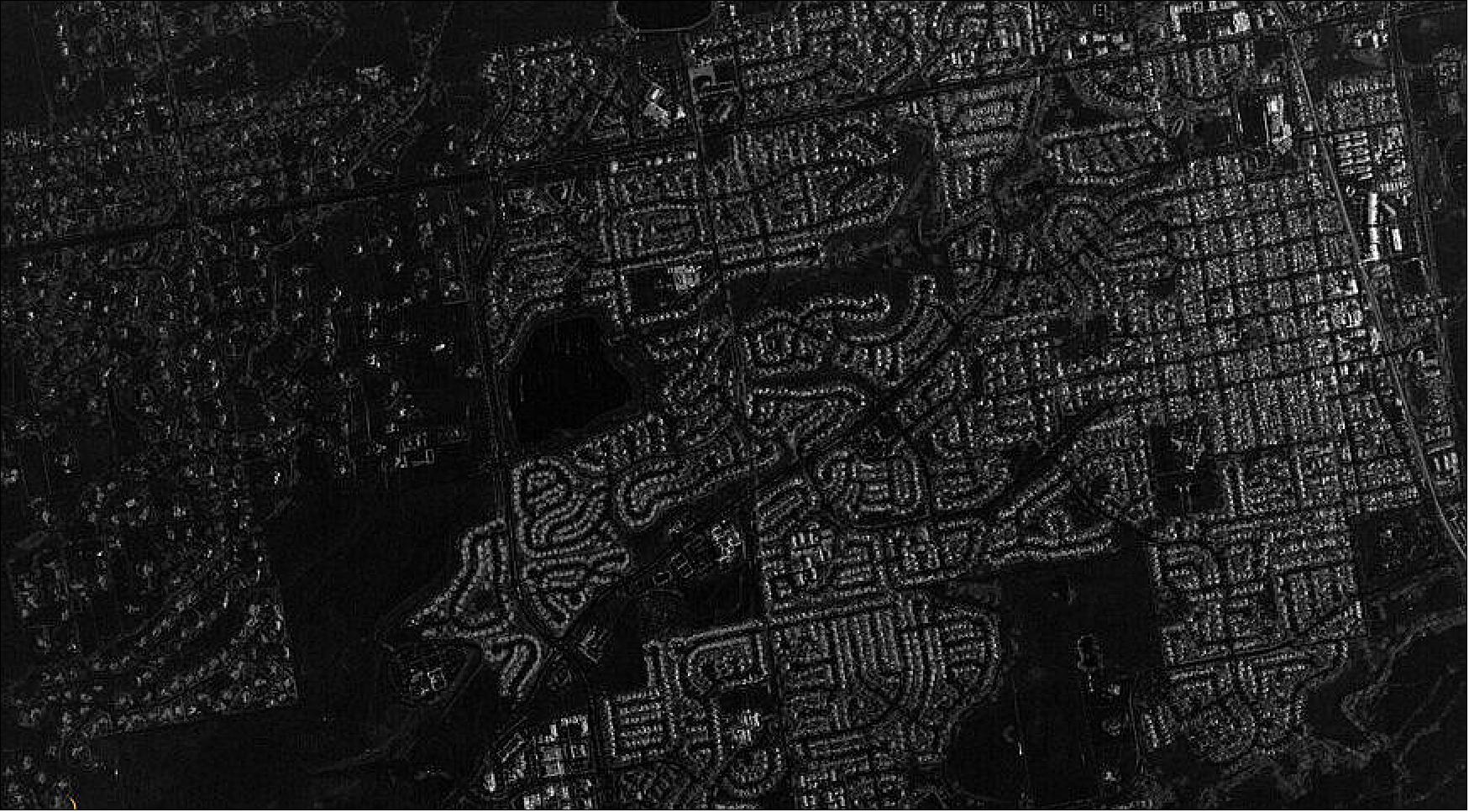
• April 14, 2022: Capella Space announced three new integrated analytics capabilities into its image-tasking web application, the Capella Console. Vessel Detection (which, by use of artificial intelligence, can identify and locate maritime vessels from satellite images), Change Detection (users can create automated monitoring campaigns that compare changes over time for an area of interest), and Global Change Monitoring (users have more access and more insight into all corners of the globe via the Global Change Monitoring product) support Capella's vision to offer a fully automated image tasking system that provides customers with timely, reliable, and accurate imagery capture and data analysis. 25) With these new products, Capella expands its services so government and commercial customers can not only task and collect high-resolution SAR imagery on demand, but also gain automated insights into what the imagery is showing.
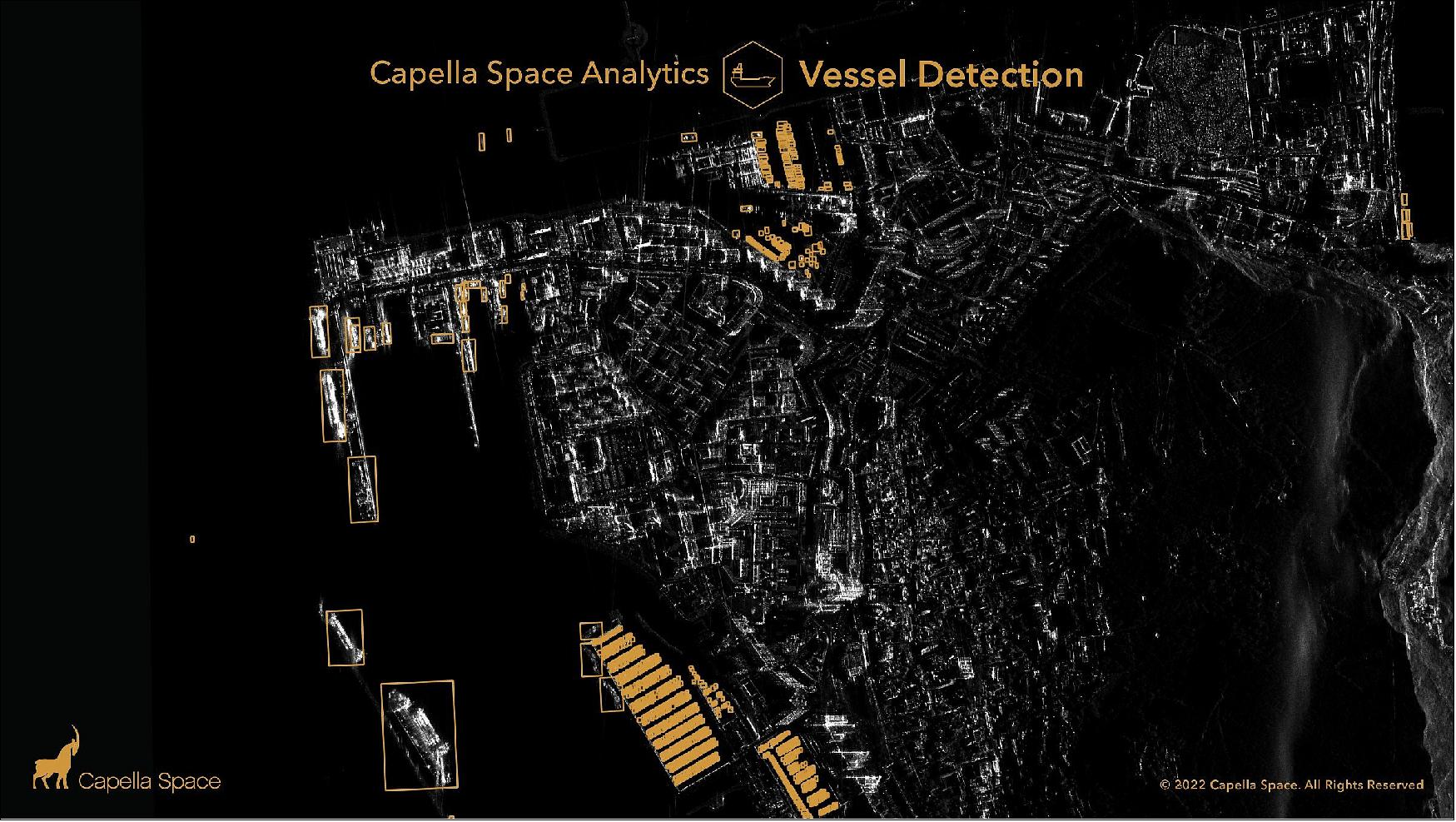
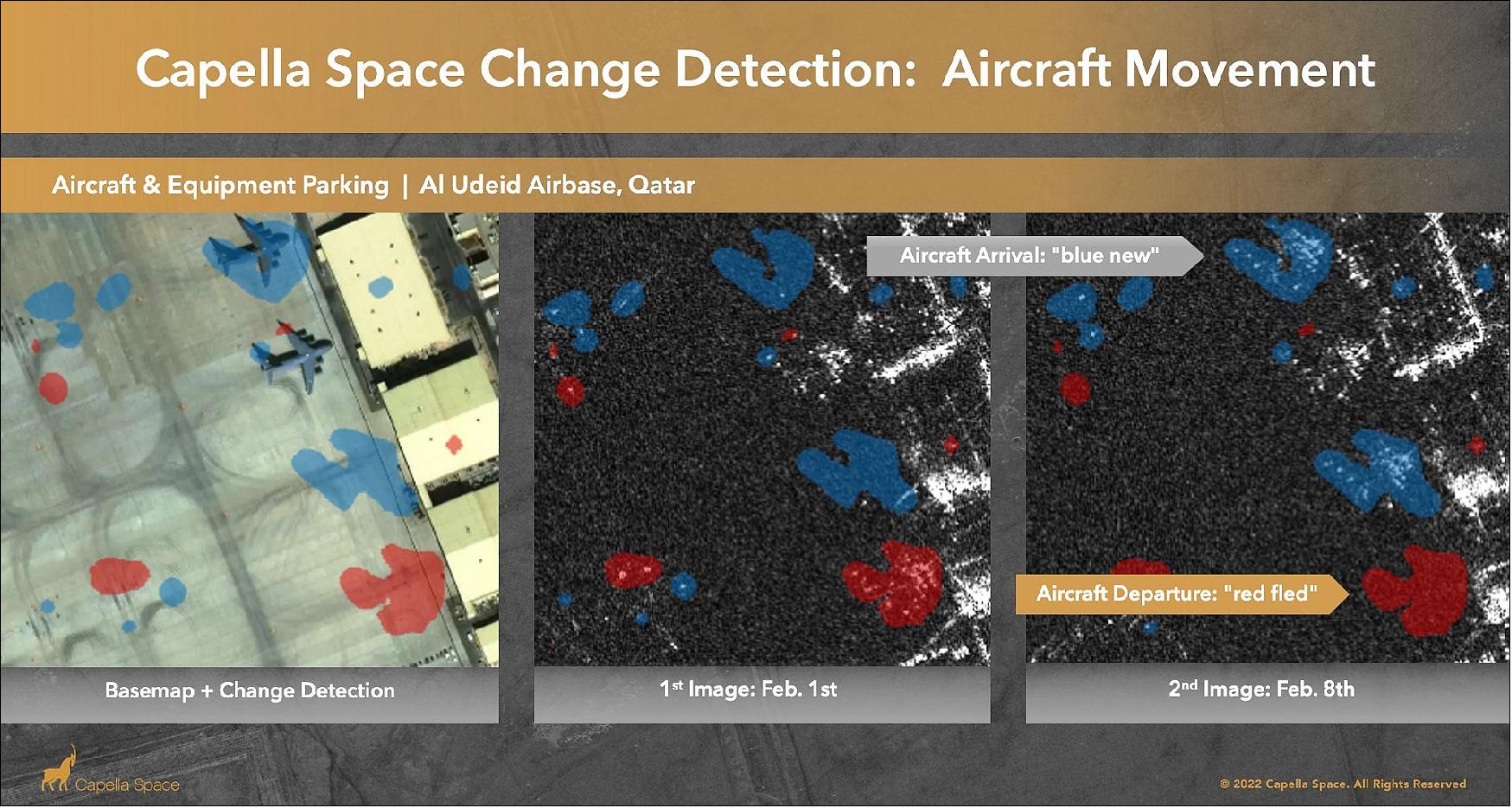
• January 13, 2022: The Capella-7 (Whitney 5) & Capella-8 (Whitney 6) SAR small satellites of Capella Space were launched as passenger payloads by a Falcon 9 Block 5 vehicle of SpaceX at 15:25 UTC on the SpaceX Transporter-3 rideshare mission (total of 105 satellites on the flight). 23)
• November 9, 2021: Capella Space announced the installation of optical communications terminals on SAR satellites by 2022 as part of a campaign to quickly deliver data to the Pentagon Space Development Agency’s (SDA) new National Defense Space Architecture, the company announced Nov. 9. 26) “Enabling our satellites to integrate with the new SDA architecture efficiently is a critical step for us to work seamlessly with the U.S. defense and intelligence sector. We are proud to be able to work with the SDA in demonstrating this cutting-edge technology.” Christian Lenz, Capella Space chief technology officer, said in a statement. Capella selected Mynaric’s CONDOR Mk3 Optical Communications Terminal to transmit data from its own satellites in low Earth orbit to government satellites and to military ground stations.
• October 21, 2021: Capella Space is working with the U.S. Army Space and Missile Defense Technical Center (SMDTC) to satisfy Army demand for Earth observation with rapid tasking and delivery of synthetic-aperture radar (SAR) data. 27) Under a Cooperative Research and Development Agreement (CRADA) announced Oct. 21, Capella and the U.S. Army Payload Development Lab are to explore applications for SAR through simulation and testing. Capella continues to establish relationships with the U.S. government agencies after last year’s contracts with the U.S. Navy, U.S. Air Force, U.S. Space Force, National Geospatial-Intelligence Agency and the Pentagon Space Development Agency. Government agencies around the world are key customers for SAR, which can peer through clouds and capture imagery day and night. In addition to the imagery, SAR data can reveal the material properties of objects as well as provide information on moisture, elevation and small changes in the position of objects. “The U.S. Government is still the largest customer of SAR data, but we are actively building a market for commercial applications that help companies and nongovernmental organizations make better economic decisions,” said Payam Banazadeh, Capella’s CEO.
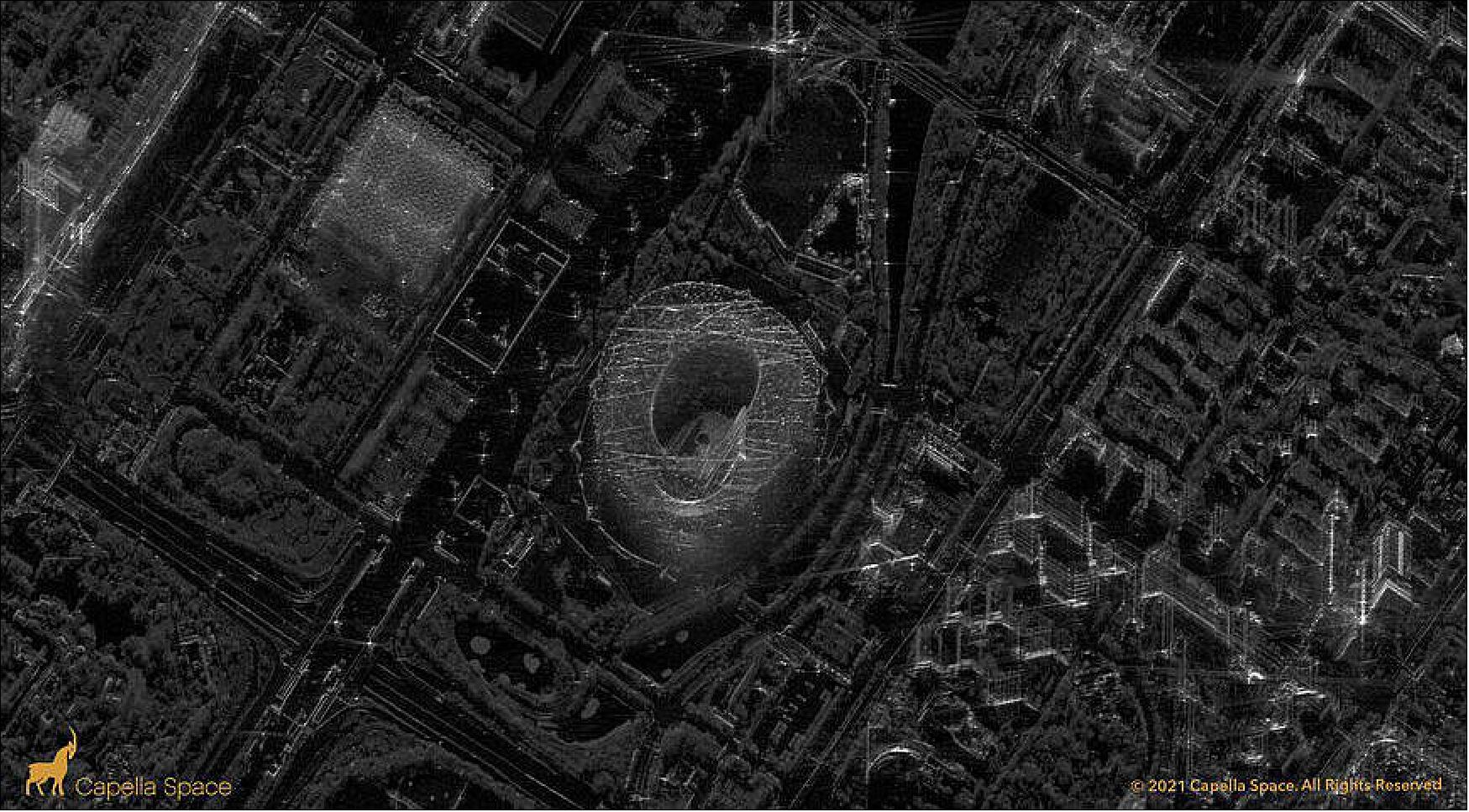
• September 14, 2021: Capella Space announced plans to share SAR data gathered by its satellite constellation with researchers, nonprofit organizations, application developers and disaster response organizations. 28) Users of Capella’s Open Data Program will gain access to updated and historical imagery and data from the Capella Console, San Francisco startup’s online platform. Open Data Program currently consists of 60 high-resolution SAR scenes of sites on every continent, showing agriculture and aquaculture, energy and natural resources, infrastructure, maritime, environmental, humanitarian disasters and natural disasters. Through the initiative, Capella intends “to foster innovation and discover the next game-changing applications of SAR” says Jason Brown, Capella community enablement engineer, wrote in a Sept. 14 blog post.
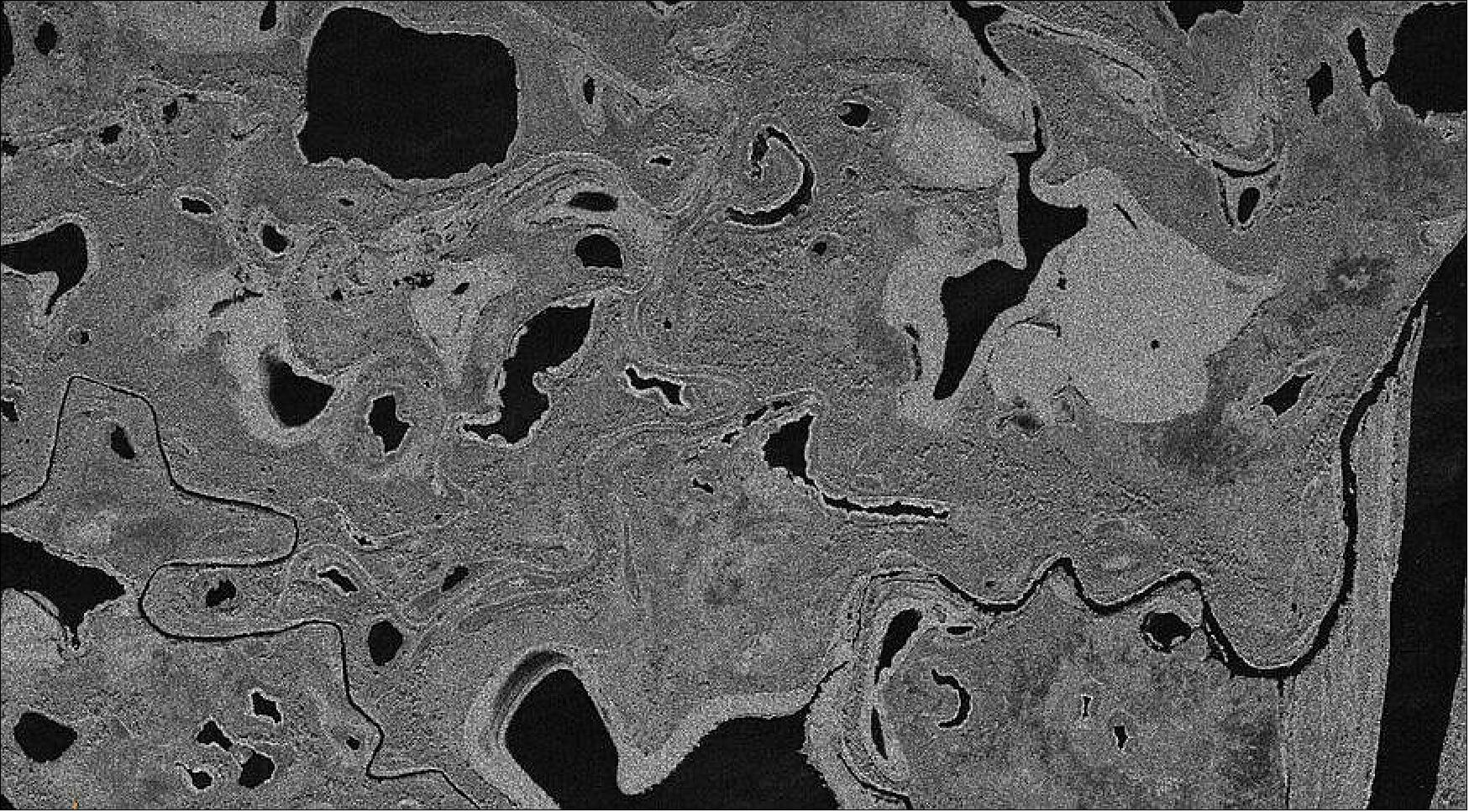
• June 30, 2021: The Capella-5 (Capella Whitney 3) SAR small satellite with a mass of ~ 110 kg was launched as a passenger payload by a Falcon 9 Block 5 vehicle at 19:31 UTC, on the SpaceX Transporter-2 mission. The launch site was the Space Launch Complex 40 at the Cape Canaveral Space Force Station. 21)
Deployment of the payload of 88 satellites started nearly 58 minutes after liftoff, once the upper stage performed a second burn of its engine to place it into a sun-synchronous orbit at an altitude of nearly 550 km and an inclination of 97.5º. The satellites, from a variety of government and commercial customers, were released over half an hour.
Capella Space launched its Capella-5 small satellite with a Maxwell electric thruster manufactured by propulsion startup Phase Four. 22)
• June 17, 2021: Capella Space on June 14 received a $3 million research contract in support of the Space Development Agency’s National Defense Space Architecture. 29) Capella Space was selected through a “broad agency announcement” issued by the space agency in January seeking proposals on a wide range of technologies for “National Defense Space Architecture Systems, Technologies, and Emerging Capabilities.”
• June 9, 2021: Capella Releases Two New SAR Data Products: Geocoded Ellipsoid Corrected (GEC) and Sensor Independent Complex Data (SICD).
• May 28, 2021: Capella Space released the first light images from Capella-6, the latest satellite added to their SAR satellite constellation, launched just 5 days earlier on the SpaceX Starlink 28 mission. This is a breakthrough in the SAR industry, as the standard for imagery deliveries of an already orbiting satellite used to be of 5 days. In this same amount of time, Capella have launched, commissioned, and collected imagery. 30)
• May 15, 2021: SpaceX Falcon 9 vehicle launched a set of 52 Starlink satellites, the Capella-6 (Capella Whitney 4) SAR small satellite, and a Tyvak-0310 nanosatellite (6U CubeSat), at 22:56 UTC from Launch Complex 39A (LC-39A) at Kennedy Space Center in Florida. 20)
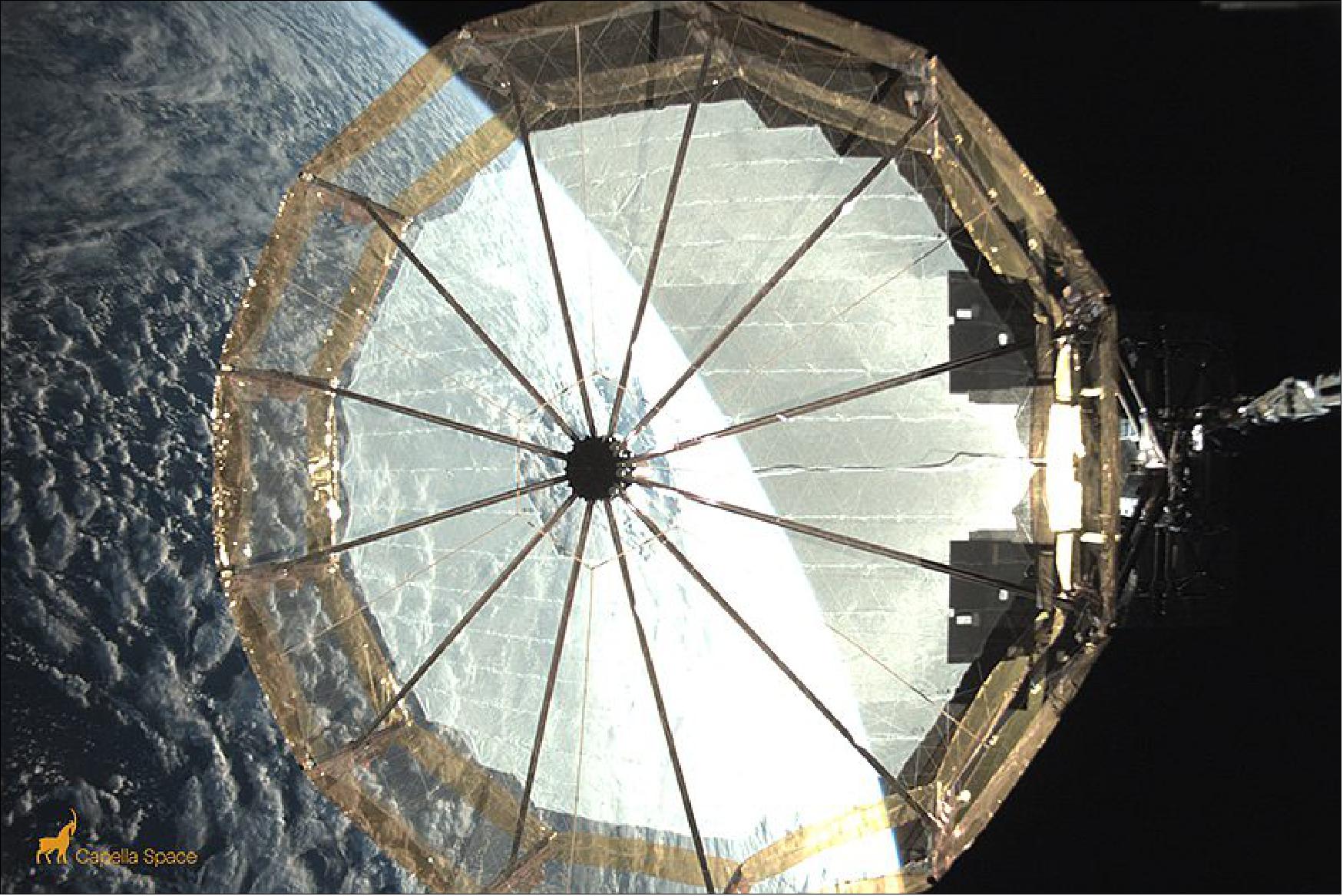
Figure 12: Reflector Antenna Deployment. Final deployment of the mesh-based reflector antenna. (image credit: Capella Space)
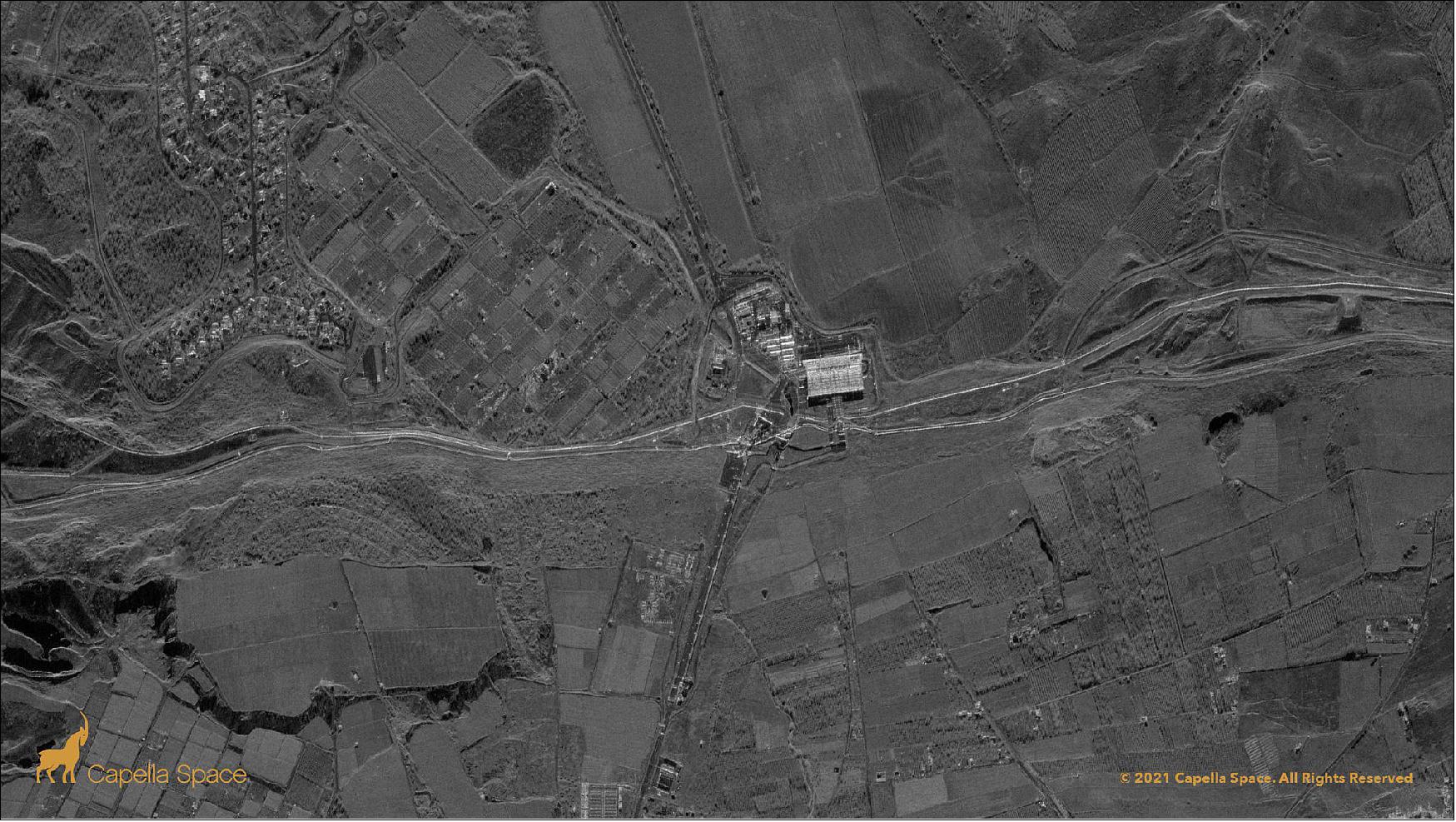
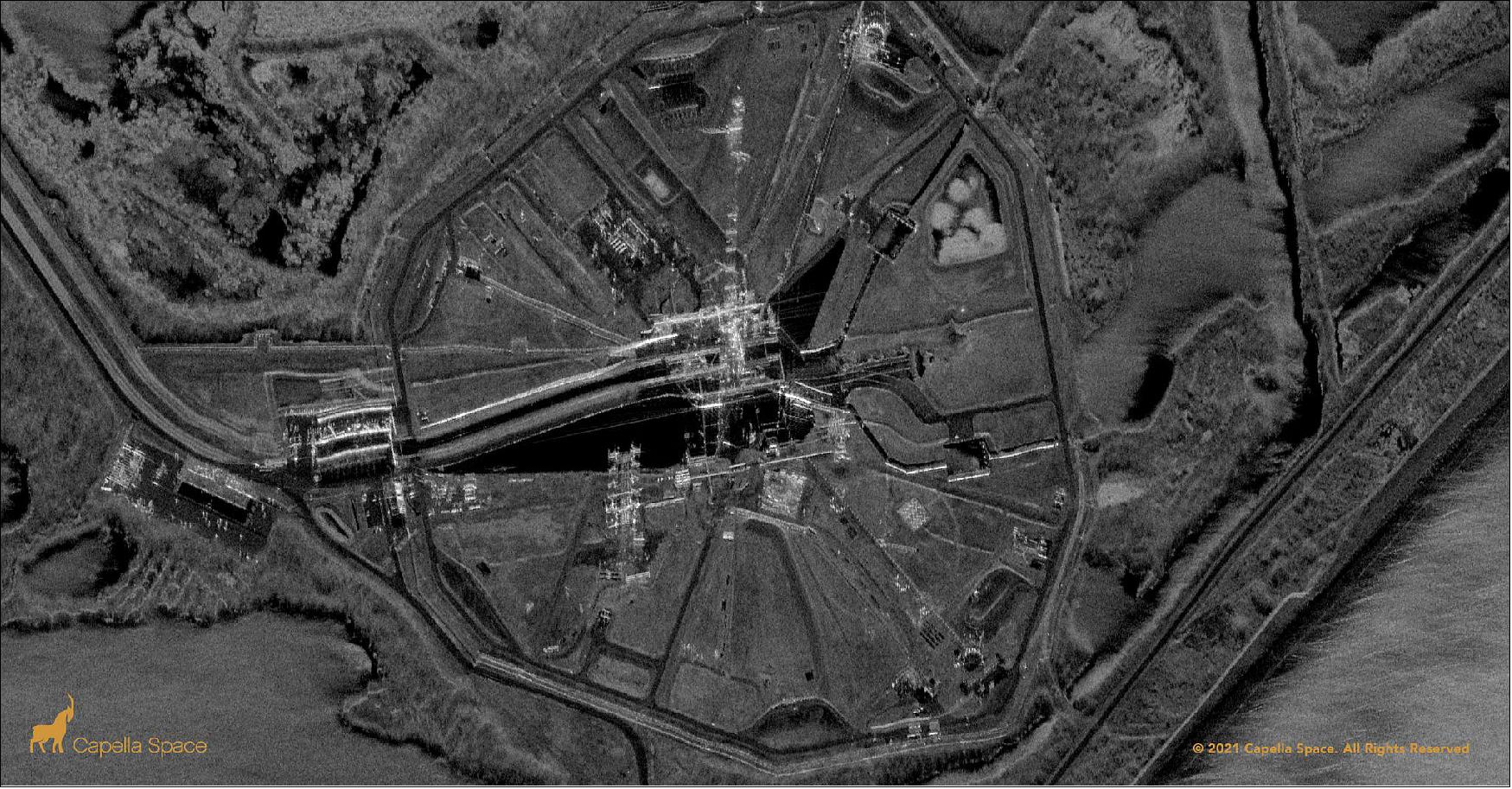
• April 14, 2021: Capella Space Accelerates 2021 Growth with New Chief Financial Officer and Expanded Leadership Team (Link)
• March 12, 2021: Capella Space Welcomes Dan Getman, VP of Product (Link)

• January 24, 2021: The Capella-3 (Capella Whitney 1) and Capella-4 (Capella Whitney 2) small satellites were launched on the SpaceX first Rideshare mission called Transporter-1. SpaceX launched a Falcon 9 Block 5 rocket from the Cape Canaveral Air Force Station (SLC-40) with 143 small satellites, a record number of spacecraft on a single mission, giving a boost to startup space companies and stressing the U.S. military’s tracking network charged with sorting out the locations of all objects in orbit. This SpaceX mission carried also 10 Starlink satellites into orbit. 19)
• December 16, 2020: Capella is the highest resolution commercial SAR provider in the world, capable of 50 cm x 50 cm resolution imaging with up to 500 MHz of bandwidth (which is announced to be improved to 1.2 GHz in the next generations). Prior to Capella, the best resolution on the market was 1 m x 25 cm, with non-square pixels which created its own challenges, and limited bandwidth of 300 MHz. Capella satellites could dwell on a single target for as long as 60 seconds, which far exceeds previous technology which could only dwell for a few seconds. Images of this resolution can be used to better track vegetation fires or to make disappearing planes a matter of the past. The high-resolution images are available to the customers through the Capella Console and API.
Capella’s Spot product is a specialized mode that allows for long exposures over an area of interest (AOI) and results in clear SAR imagery. This 50 cm x 50 cm imagery is collected by dwelling the satellites over an AOI for a long period.
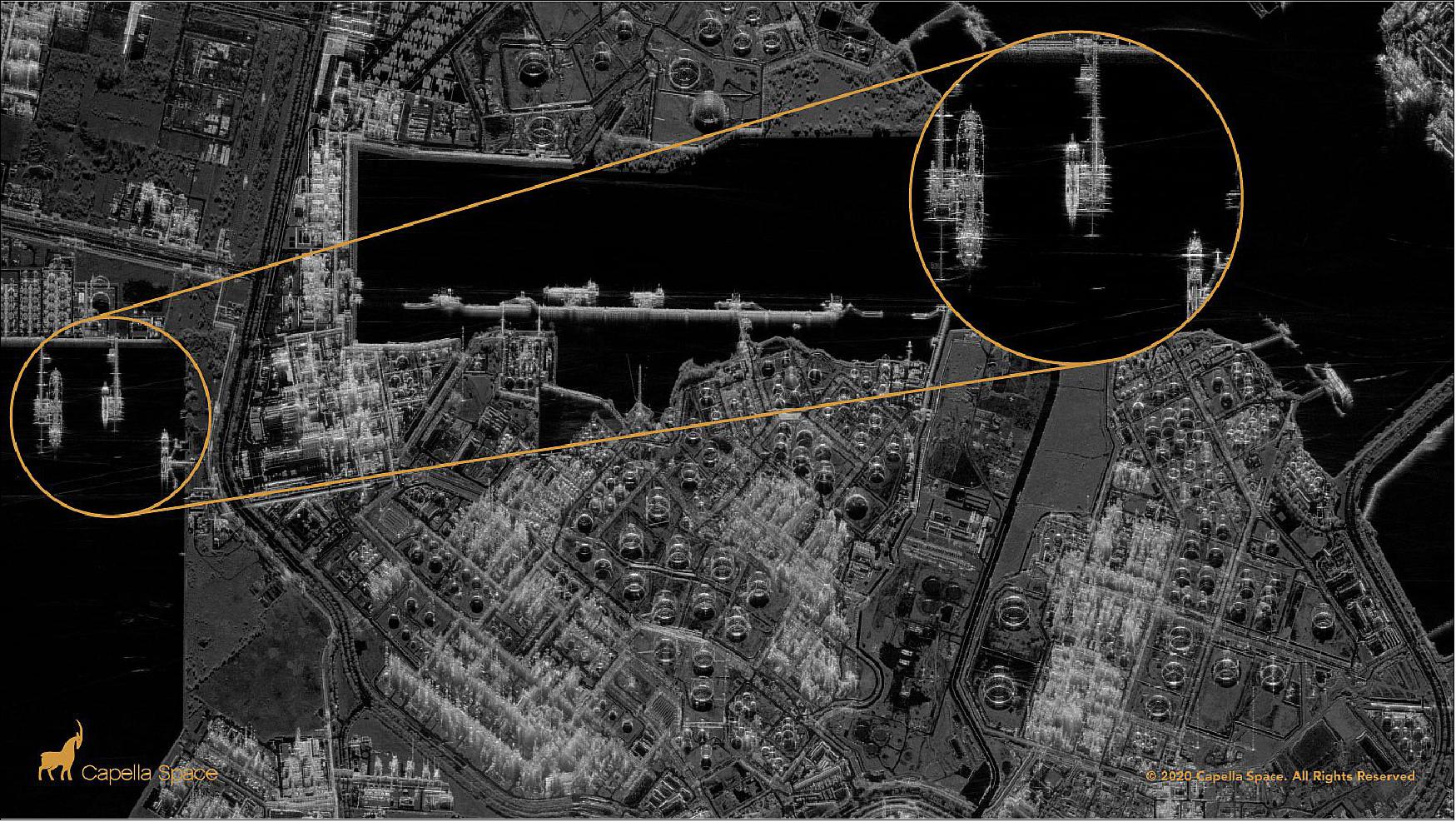

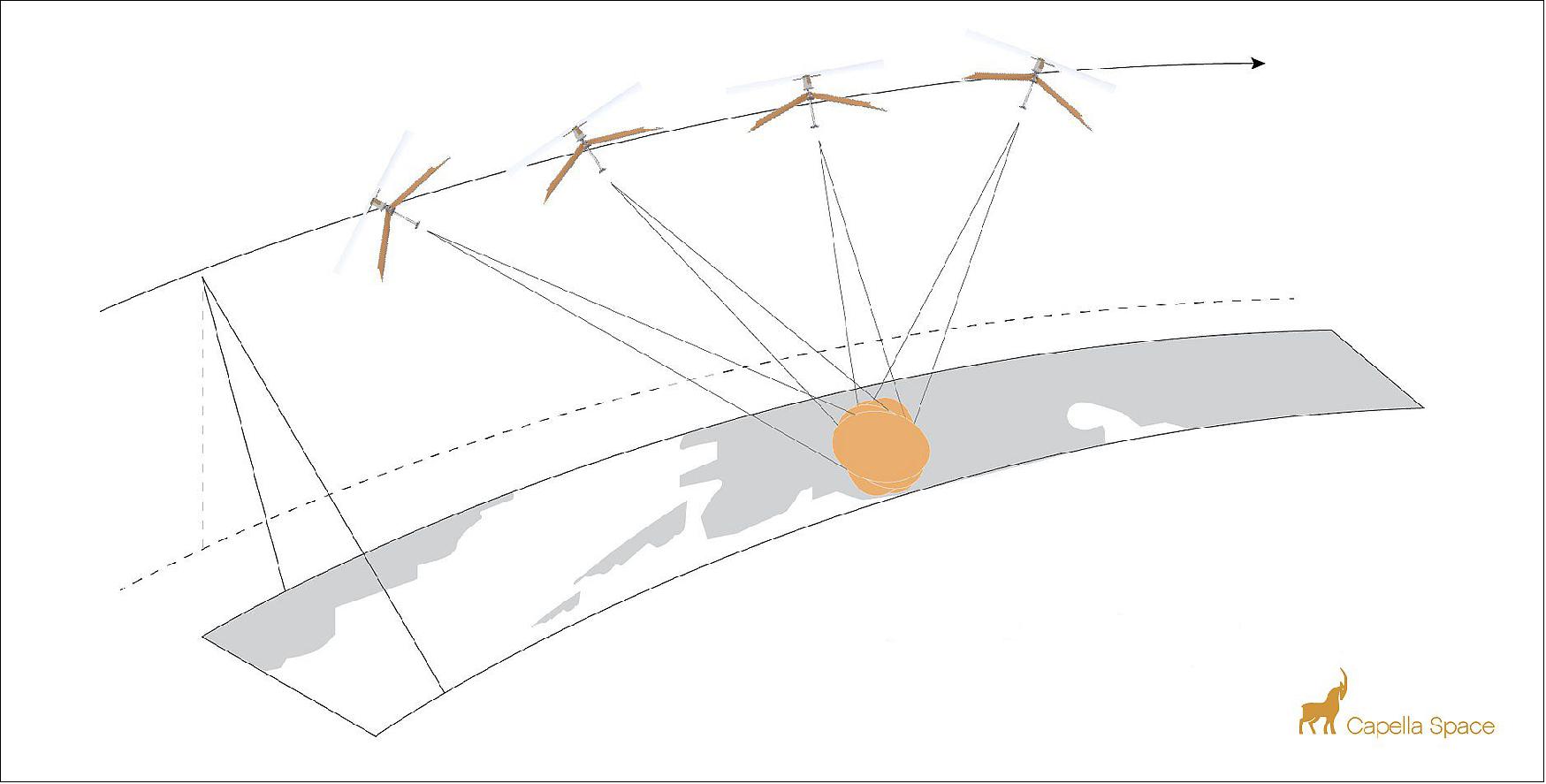
• November 23, 2020: Fleet operator Inmarsat and communications technology firm Addvalue Innovation announced success relaying data between Capella Space’s operations center on the ground and Capella’s Sequoia SAR satellite in low Earth orbit. 32) For years, London-based Inmarsat and Addvalue Innovation, a subsidiary of Singapore-based Addvalue Technologies Ltd., have worked together to establish a commercial Intersatellite Data Relay System (IDRS) to continuously link satellites in low Earth orbit with ground networks. This has now become possible due to Capella’s SAR satellites. Capella Space conducted the first commercial demonstration of the IDRS service Nov. 12 when it sent tasking orders to Sequoia through the Inmarsat-4 L-band constellation in geostationary orbit. Inmarsat and Addvalue also expect IDRS technology to be adopted by customers gathering climate data and performing disaster relief missions because it allows operators to send commands to satellites without waiting for them to pass over ground stations. “This real-time connectivity will allow us to significantly reduce the time between customer tasking requests and when we collect the data on-orbit.” said Christian Lenz, Capella Space vice president of engineering.
• August 30, 2020: Capella-2 (nicknamed Sequoia) payload, a 107 kg SAR small satellite , was launched at 03:05 UTC on a Rocket Lab Electron vehicle from New Zealand's Launch Complex 1 at Mahia. This was a dedicated mission for Capella Space Corporation of Palo Alto, California. Capella Space named the mission: 'I Can't Believe It's Not Optical.' 18)
• July 9, 2020: Capella Space has signed a Cooperative Research and Development Agreement (CRADA) with the National Geospatial-Intelligence Agency (NGA). The CRADA gives Capella access to NGA researchers for deeper insight into problems and in return NGA gains access to Capella Space’s SAR data and analytics services and signifies NGA’s first research partnership with an American commercial small satellite SAR data company, in an effort to expand its research capabilities. 35) . Capella will play a critical role in satisfying NGA’s mission to expand its production and publication of unclassified operations and intelligence. The CRADA further strengthens Capella Space’s already-trusted relationship with United States government agencies. This past May, Capella Space signed a contract with the Department of Defense to provide on-demand, high-resolution SAR data and analytics for the U.S. Navy.
• June 30, 2020: Capella Space runs its entire IT infrastructure on AWS to automate and scale its operations. Capella leverages AWS storage, database, machine learning, and analytics services to process the terabyte-size data collected daily by the satellites. The finessed data is immediately available upon downlink, helping its customers quickly gain insights for dynamic applications such as detecting illegal maritime activities and assessing the impact of natural disasters. Furthermore, Capella is developing a searchable archive of Earth observation data in the cloud, providing its customers with benchmark data so they can track subtle changes to the environment, discerning patterns over time to help them inform business and policy decisions.36)
• March 5, 2020: Capella Space and Rocket Lab to Launch Mid-Inclination Satellite to Enable Improved Monitoring of Key Global Regions (Link)
• January 21, 2020: Capella Space Unveils Advanced Satellite Design to Deliver High Resolution On-Demand Earth Observation Data (Link)
Capella's first testbed satellite Denali, as well as ground-based testing. Enhancements include:
- Advanced design delivering high contrast, low-noise, sub-0.5 meter imagery: A 3.5 meter deployed mesh-based reflector antenna combined with a high power RADAR enable key performance improvements including quality advances.
- Extended duty cycle: A deployed 400 W solar array increases on-orbit duty cycle to 10 minutes per orbit.
- Continuous imaging over long distance: Advanced thermal management systems allow continuous imaging of up to 4000 km long strip images.
- Highly agile platform: Enabled by large reaction wheels, the new satellite quickly adjusts pointing to collect images from diverse targets.
- Staring spotlight image mode: New mode further enhances image quality with the ability to collect the highest commercially available multi-look data.
- Enhanced data downlink rate: A high average data rate downlink of 1.2 Gbit/s supports the massive image collection rate and extended duty cycle, providing more data per orbit than any other commercial SAR system in its class.
- Real-time tasking: A highly secure encrypted two-way link with Inmarsat through an exclusive partnership with Addvalue provides real time tasking capability for the entire Capella constellation.
• December 16, 2019: Capella to Start Commercial Operations in 2020 with Launch of Seven Synthetic Aperture Radar Satellites (Link)
• September 3, 2019: Capella Space Partners with SpaceNet® to Expand Access to SAR Data (Link)
Capella joins the collaborative SpaceNet partnership alongside In-Q-Tel’s (IQT) CosmiQ Works, Maxar Technologies, Intel AI and Amazon Web Services (AWS). Capella’s addition to the partnership presents an exciting opportunity to expand SpaceNet’s existing geospatial open source research to a new data type, Synthetic Aperture Radar (SAR).
• August 5, 2019: Capella Space Partners with Addvalue and Inmarsat for Real-time Tasking (Link), a one-stop digital, wireless and broadband communications technology products innovator, for the use of its Inter-Satellite Data Relay System (IDRS™) via Inmarsat’s global L-band satellite communications network. The Inmarsat network provides satellite uplink and downlink services, which enable Capella to task any satellite in its constellation in any location in the world in real-time. Through its agreement with Addvalue, Capella will have a significant market lead as the only SAR (Synthetic Aperture Radar) provider with real-time tasking capability.
• June 3, 2019: Capella Space (having at that point over 50 employees and $50 million financing) launched the first small U.S. radar satellite in December 2018, whose purpose was to set the ground for the desired constellation of 36 synthetic aperture radar satellites. The main advantage of these satellites is that, unlike electro optical satellites which require light, radar satellites capture imagery during the day, at night and through clouds. Capella plans to launch Sequoia, its first operational satellite. Capella also is establishing its infrastructure to allow customers to downlink satellite data directly. 37)
• December 3, 2018: Capella Space announced today the launch of its first small synthetic aperture radar (SAR) satellite. The satellite, named "Denali" after the tallest mountain in the U.S., will allow Capella to fine-tune their technology and operations as they progress toward reliably delivering hourly information and imagery in any condition anywhere on Earth. This launch marks a pivotal moment for American innovation, as Capella is the first and only U.S. company to develop and launch a radar satellite for commercial markets. 15)
Capella Space Is First American Company to Send Advanced Commercial Radar Satellite to Space (Link).
• September 26, 2018: Capella Space Closes $19M Series B to Deliver Reliable Earth Observation Data on Demand(Link)
• March 2018: NOAA awarded Capella a license to send two X-band SAR satellites into polar orbits between 450 to 600 km with an inclination of ~97.5º.
References
1) Gordon Farquharson, William Woods, Craig Stringham, Navneet Sankarambadi, Lucas Riggi, ”The Capella Synthetic Aperture Radar Constellation,” Proceedings of IGARSS (International Geoscience and Remote Sensing Symposium), Valencia, Spain, July 23-27, 2018
2) Debra Werner, ”Capella’s first satellite launching this fall,” Space News, 8 August 2018, URL: https://spacenews.com/capellas-first-satellite-launching-this-fall/
3) Craig Stringham, Gordon Farquharson, Davide Castelletti, Eric Quist, Lucas Riggi, Duncan Eddy, and Scott Soenen, ”The Capella X-band SAR constellation for rapid imaging,” Proceedings of the 39th annual IGARSS (International Geoscience and Remote Sensing Symposium) 2019, Yokohama, Japan, 28 July - 2 August 2019
4) Sandra Erwin, ”Capella Space wins research contract from U.S. Space Development Agency,” SpaceNews, 17 June 2021, URL: https://spacenews.com/capella-space-wins-research-contract-from-u-s-space-development-agency/
5) ”Capella Space And Rocket Lab To Launch Mid-Inclination Satellite To Enable Improved Monitoring of Key Global Regions,” Spacewatch, 5 March 2020, URL: https://spacewatch.global/2020/03/capella-space-and-rocket-lab-to-launch-mid-inclination-satellite-to-enable-improved-monitoring-of-key-global-regions/
6) ”Capella Space Partners with SpaceNet and Others for Collaborative AI-Based Geospatial Research,” Satnews, 3 September 2019, URL: http://www.satnews.com/story.php?number=2116101381
7) ”Capella Space Unveils Advanced Satellite Design to Deliver High Resolution On-Demand Earth Observation Data,” PR Newswire, 21 January 2020, URL: https://www.prnewswire.com/news-releases/capella-space-unveils-advanced-satellite-design-to-deliver-high-resolution-on-demand-earth-observation-data-300989916.html
8) Sandra Erwin, ”Capella Space to launch seven radar satellites in 2020 as it prepares for commercial operations,” Space News, 16 December 2019, URL: https://spacenews.com/capella-space-to-launch-seven-radar-satellites-in-2020-as-it-prepares-for-commercial-operations/
9) ”Capella Space closes $19M Series B to deliver reliable Earth observation data on demand,” PR Newswire, 26 September 2018, URL: https://www.prnewswire.com/news-releases/capella-space-closes-19m-series-b-to-deliver-reliable-earth-observation-data-on-demand-300719051.html
10) http://spaceflight.com/sp-customers/customer-2/
11) Stephen Clark, ”Spaceflight’s 64-satellite rideshare mission set to last five hours,” Spaceflight Now, 3 December 2018, URL: https://spaceflightnow.com/2018/12/03/spaceflights-64-satellite-rideshare-mission-set-to-last-five-hours/
12) Stephen Clark, ”Spaceflight preps for first launch of unique orbiting satellite deployers,” Spaceflight Now, 23 August 2018, URL: https://spaceflightnow.com/2018/08/23/spaceflight-preps-for-first-launch-of-unique-orbiting-satellite-deployers/
13) Jeff Foust, ”Spaceflight gears up for dedicated Falcon 9 launch,” Space News, 6 August 2018, URL: https://spacenews.com/spaceflight-gears-up-for-dedicated-falcon-9-launch/t).
14) ”Spaceflight SSO-A: SmallSat Express Mission,” SpaceX, 3 December 2018, URL: https://web.archive.org/web/20181204085402/https://www.spacex.com/news/2018/12/03/spaceflight-sso-smallsat-express-mission
15) ”Capella Space Is First American Company to Send Advanced Commercial Radar Satellite to Space,” PR Newswire Press Release, 3 December 2018, URL: https://markets.businessinsider.com/news/stocks/capella-space-is-first-american-company-to-send-advanced-commercial-radar-satellite-to-space-1027777044
16) ”Spaceflight - Introducing SSO-A: The smallsat express,” Spaceflight, 3 December 2018, URL: http://spaceflight.com/sso-a/
17) ”Statement from Spaceflight, the Mission Manager, Launches 64 Satellites on First Dedicated Rideshare Mission,” Satnews Daily, 4 December 2018, URL: http://www.satnews.com/story.php?number=270036615
18) ”I Can't Believe It's Not Optical,” Rocket Lab, 31 August 2020, URL: https://www.rocketlabusa.com/missions/completed-missions/i-cant-believe-its-not-optical/
19) Stephen Clark, ”SpaceX smashes record with launch of 143 small satellites,” Spaceflight Now, 24 January 2021, URL: https://spaceflightnow.com/2021/01/24/spacex-launches-record-setting-rideshare-mission-with-143-small-satellites/
20) ”Recent Launch Starlink Mission,” SpaceX, 15 May 2021, URL: https://www.spacex.com/launches/
21) Jeff Foust, ”SpaceX launches second dedicated rideshare mission,” SpaceNews, 30 June 2021, URL: https://spacenews.com/spacex-launches-second-dedicated-rideshare-mission/
22) Debra Werner, ”Capella Space and Phase Four reveal Maxwell Engine performance,” SpaceNews, 30 June 2021, URL: https://spacenews.com/phase-four-flight-heritage/
23) Stephen Clark, ”SpaceX launches 105 customer satellites on third Transporter rideshare mission,” Spaceflight Now, 13 January 2022, URL: https://spaceflightnow.com/2022/01/13/spacex-launches-105-customer-satellites-on-third-transporter-rideshare-mission/
24) Debra Werner, ”Capella raises $97 million to expand radar constellation,” SpaceNews, 25 April 2022, URL: https://spacenews.com/capella-series-c/
25) ”Capella Space Announces New Data Products to Automate SAR Imagery Analysis Via Its Image-Tasking Console,” PR Newswire, 14 April 2022, URL: https://www.prnewswire.com/news-releases/capella-space-announces-new-data-products-to-automate-sar-imagery-analysis-via-its-image-tasking-console-301525673.html
26) Debra Werner, ”Capella to install optical terminals to share data with SDA,” SpaceNews, 9 November 2021, URL: https://spacenews.com/capella-sda-demonstration/
27) Debra Werner, ”Capella to work with U.S. Army Space and Missile Defense Technical Center,” SpaceNews, 21 October 2021, URL: https://spacenews.com/capella-army-sar-crada/
28) Debra Werner, ”Capella shares SAR data with researchers, app developers,” SpaceNews, 14 September 2021, URL: https://spacenews.com/capella-open-data-program/
29) Sandra Erwin, ”Capella Space wins research contract from U.S. Space Development Agency,” SpaceNews, 17 June 2021, URL: https://spacenews.com/capella-space-wins-research-contract-from-u-s-space-development-agency/
30) Payam Banazadeh, ”Capella Space Commissions its Latest Satellite in 5 Days,” Capella Space, 28 May 2021, URL: https://www.capellaspace.com/capella-space-commissions-its-latest-satellite-in-5-days/
31) Payam Banazadeh, ”Capella Unveils World’s Highest Resolution Commercial SAR Imagery,” Capella Space, 16 December 2020, URL: https://www.capellaspace.com/capella-unveils-worlds-highest-resolution-commercial-sar-imagery/
32) Debra Werner, ”Capella sends first task order through Inmarsat data relay,” SpaceNews, 23 November 2020, URL: https://spacenews.com/capella-sends-first-task-order-through-inmarsat-data-relay/
33) Scott Soenen, ”The key benefits a SAR constellation can bring to Earth observation,” Capella Space Blog, 10 July 2020, URL: https://www.capellaspace.com/the-key-benefits-a-sar-constellation-can-bring-to-earth-observation/
34) Adam O'Connor, ”Capella’s Advanced SAR Imagery Products,” Capella Space Blog, 8 May 2020, URL: https://www.capellaspace.com/capellas-advanced-sar-imagery-products/
35) ”Capella Space Now Has a Research Partnership with the NGA,” Satnews, 9 July 2020, URL: https://news.satnews.com/2020/07/09/capella-space-now-has-a-research-partnership-with-the-nga/
36) ”Capella uses space to bring you closer to Earth,” AWS, 30 June 2020, URL: https://aws.amazon.com/blogs/publicsector/capella-uses-space-bring-you-closer-earth/
37) Debra Werner, ”Capella Space gets ready for primetime as constellation operator,” SpaceNews 3 June 2019, URL: https://spacenews.com/capella-space-gets-ready-for-primetime-as-constellation-operator/
38) Krebs, Gunter D. “Capella 2, ..., 10 (Sequoia, Whitney)”. Gunter's Space Page.URL: https://space.skyrocket.de/doc_sdat/capella-2.htm
39) Jeff Foust, 16 March, 2023, “Electron launches two Capella Space radar satellites”. URL: https://spacenews.com/electron-launches-two-capella-space-radar-satellites/
40) Wikipedia, “Capella Space”, URL: https://en.wikipedia.org/wiki/Capella_Space
41) Foust, Jeff, “Electron fails during Capella Space launch”, Space News, September 19, 2023, URL: https://spacenews.com/electron-fails-during-capella-space-launch/
42) Sat News, “Rocket Lab launches their 40th Electron mission + successfully flies a reused Rutherford engine”, August 23, 2023, URL: https://news.satnews.com/2023/08/23/rocket-lab-launches-their-40th-electron-mission-successfully-flies-a-reused-rutherford-engine/
43) Space.com, “Rocket Lab suffers anomaly during launch, Earth-observation satellite lost”, September 19, 2023, URL: https://www.space.com/rocket-lab-electron-launch-failure-september-2023
44) In-The-Sky.org, CAPELLA-6-WHITNEY, URL: https://in-the-sky.org/spacecraft.php?id=48605
45) Foust Jeff, “Rocket Lab launches Capella Space SAR satellite”, SpaceNews, August 11, 2024, URL: https://spacenews.com/rocket-lab-launches-capella-space-sar-satellite/
46) Lentz Danny, “SpaceX debuts new Bandwagon rideshare service”, NASASpaceFlight, April 7, 2024, URL: https://www.nasaspaceflight.com/2024/04/bandwagon-1/
47) Lentz Danny, “SpaceX launches Transporter-11 rideshare with 116 payloads”, NASASpaceFlight, August 16, 2024, URL: https://www.nasaspaceflight.com/2024/04/bandwagon-1/
Sensor Complement Capella Spacecraft Capella Launches Mission Status References Back to top